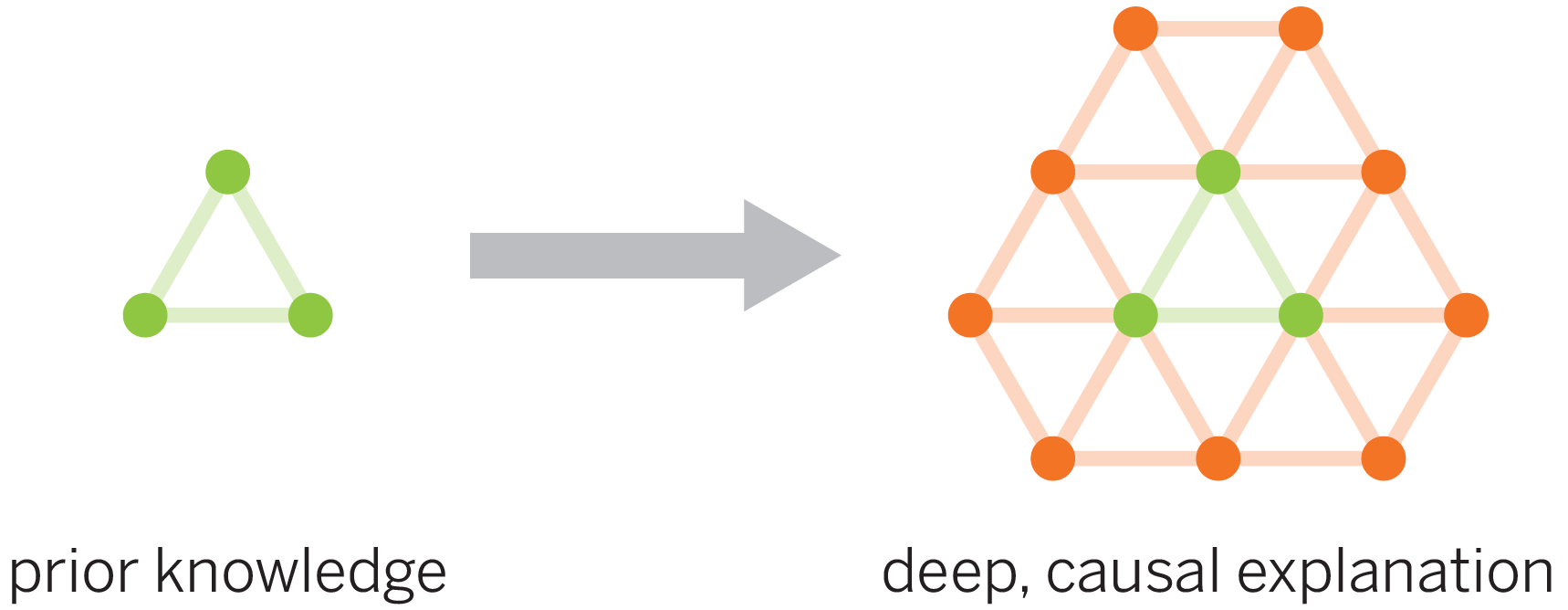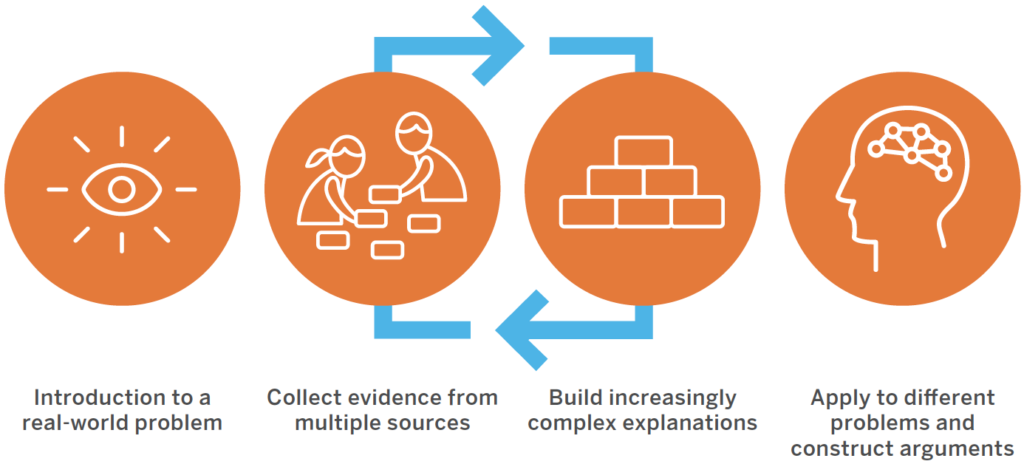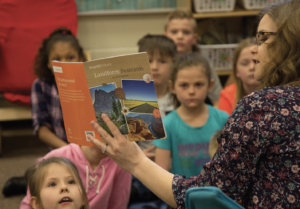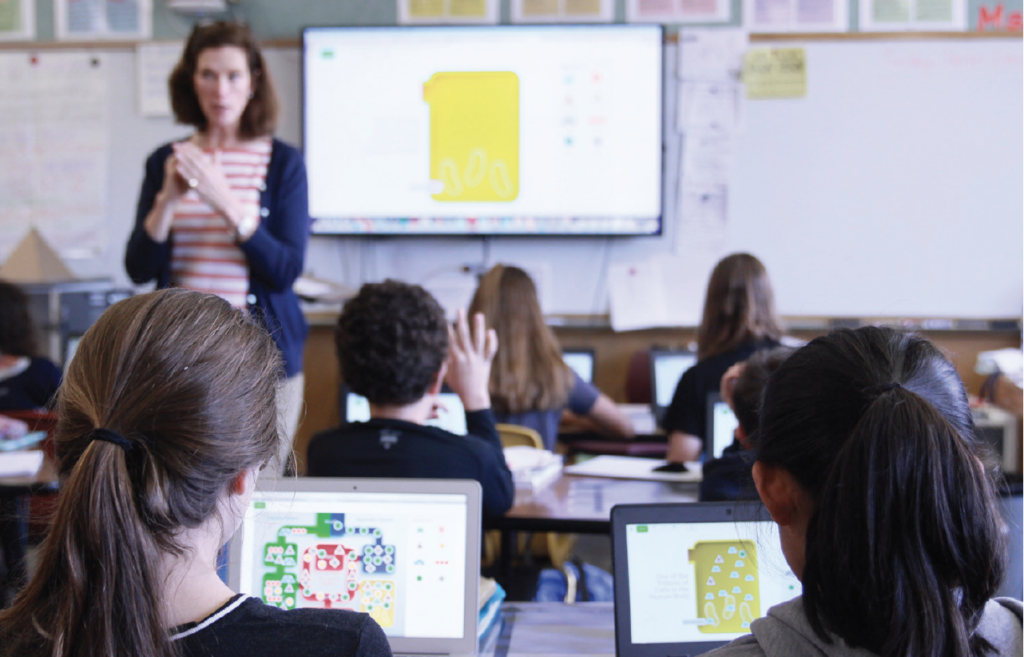Our approach
The Amplify Science approach adheres to the letter and spirit of the NGSS. Students build knowledge across disciplines in each year so that past learning is connected to new concepts, applied to new phenomena, and further developed in each successive year. The Framework-focused design of the Amplify Science curriculum is grounded in the following:
- Designed from the ground up for NGSS
- Emphasis on unit coherence
- Real-world problems and scientific phenomena
- Multimodal approach
- Explicit support for literacy development
- Expanding opportunities for visualizing
1. Designed from the ground up for NGSS
The Amplify Science curriculum developers at University of California, Berkeley’s Lawrence Hall of Science crafted each unit, chapter, and lesson with the following questions in mind:
- What do we want students to figure out? (What disciplinary core idea (DCI) or part of a DCI?),
- How do we want them to figure it out? (What scientific and engineering practice will they engage in to figure it out?)
- What crosscutting concept can scaffold students’ understanding and connect it to other ideas about the natural world that they have learned?
This resulted in a curriculum that incorporates a strategic, well-balanced integration of the three dimensions.
2. Emphasis on unit coherence

Student learning experiences and assessments are grounded in a unit-specific learning progression called a Progress Build. A Progress Build clearly defines each level of students’ increasingly sophisticated understanding of unit phenomena students should reach as they progress through the unit. Students build that understanding through engagement with science and engineering practices and application of crosscutting concepts over the course of the lessons in the unit. Thus, as students investigate the anchor phenomena for each unit, they construct new knowledge the way scientists do: through engagement with a core set of professional practices and the application of prior knowledge. Students are consequently thoroughly prepared to meet the three-dimensional learning goals articulated in the NGSS performance expectations.
3. Scientific phenomena and real-world problems
In each Amplify Science unit, students are asked to inhabit the role of a scientist or engineer in order to figure out scientific phenomena through a 21st-century, real-world problem context. Over the course of the unit, students collect and make sense of evidence from multiple sources and through a variety of modalities, ensuring that they have multiple vehicles through which to develop and articulate their understanding of each phenomenon. As the class progresses through their lessons, students move back and forth from firsthand investigation and inquiry to secondhand analysis and synthesis, formulating an increasingly complex explanation of the problem at hand. Finally, at the end of the unit, students are presented with a brand-new context to consider, giving them an opportunity to take what they’ve learned over the course of the unit thus far and apply it to this new context, thereby demonstrating a deep understanding of the phenomenon.

Examples of the phenomena-based, real-world contexts students encounter in Amplify Science include:
- In the grade 1 Spinning Earth unit, students work as space scientists to figure out an explanation for why it is never the same time of day for a grandmother, who lives in Asia, as it is for her grandson in the United States when she calls him. Students record, organize, and analyze observations of the sun and other objects in the sky as they look for patterns and make sense of the cycle of daytime and nighttime.
- In the grade 2 Changing Landforms unit, students are recruited by the fictional director of the Oceanside Recreation Center, who recently got quite a scare when a nearby cliff collapsed. In their role as geologists, students research erosion and changes to the cliff over time to advise the director on whether it is safe to keep the center open.
- In the grade 5 Modeling Matter unit, students work as food scientists for the fictional company Good Food Production, Inc., where they are given two assignments related to food safety and new product. After separating a mixture and attempting to mix unmixable substances, students summarize their findings for the president of the company.
- In the middle school Traits and Reproduction unit, students take on the role of student geneticists in order to investigate possible ways spider silk can be used for medical purposes, such as for artificial tendons. Through their investigation, they figure out what causes variation in spider silk traits. Specifically, they explore why parent spiders have offspring with widely varied silk flexibility traits. They uncover the roles of proteins and genes and the way that genes are inherited.
- In the middle school Phase Change unit, students take on the role of student chemists in order to investigate the mystery of a disappearing methane lake on Saturn’s moon, Titan. Through their investigation, they discover what causes phase changes, including the role of energy transfer and attraction between molecules.
For additional examples of anchor phenomena, visit Unit phenomena and performance expectations and browse by grade level.
4. Multimodal approach
 Amplify Science is rooted in the research-based Do, Talk, Read, Write, Visualize model of learning, where students engage with science and engineering practices, figure out disciplinary core ideas, and utilize and apply crosscutting concepts in multiple modalities across thoughtful, structured lessons.
Amplify Science is rooted in the research-based Do, Talk, Read, Write, Visualize model of learning, where students engage with science and engineering practices, figure out disciplinary core ideas, and utilize and apply crosscutting concepts in multiple modalities across thoughtful, structured lessons.
DO: “Do” means collecting firsthand evidence. This can include conducting hands-on investigations, making observations of a video clip, or collecting data using a digital simulation (“sim”), all of which can then be used as evidence in formulating a convincing scientific argument.
TALK: Student-to-student discourse is a key indicator of a productive learning environment, and talking is a key modality for instruction in an Amplify Science class. This is more than just partner activities or group work—though there’s plenty of that, too. For example, reading activities are followed by a student-to-student discussion where students share their insights and questions with each other and with the whole class. Through talking and developing a collaborative environment, students feel comfortable asking questions of one another, challenging assumptions, and learning from each other.
READ: Student texts, all written by the Lawrence Hall of Science, serve multiple purposes: They help students make connections between science concepts and additional real-world contexts; provide students with data to analyze; model science practices; and show real scientists in action. Students also learn to read actively, with explicit instruction on how to record their questions, seek evidence from text, and monitor their understanding as they read.
WRITE: Students in Amplify Science have frequent opportunities to write in order to help them reflect on and make sense of what they are learning. Across the program students learn how to express their scientific thinking by leveraging evidence and using relevant vocabulary as they apply their thinking to writing. Frequent reflective writing helps students to gain a deepening understanding of the genres of scientific arguments and explanations, both of which embody the foundation of scientific understanding and expression.
VISUALIZE: Through a combination of simulations, media, hands-on activities, readings, and digital and physical models, students are empowered to visualize scientific phenomena in ways never possible before.
5. Explicit support for literacy development

To engage in science, students need to read, write, and talk like scientists. In Amplify Science, students are not expected to come to science class knowing how to read or write science text, or to engage in science discourse. Instead, Amplify Science provides explicit instruction for students and employs the Gradual Release of Responsibility model to enable students to become independent readers and writers. Through the seamless integration of science and literacy instruction, students learn that reading, writing, and talking are essential practices of science, and that scientists use these practices to gather information, communicate claims, leverage evidence, draw conclusions from data, and share their ideas through oral and written explanations and arguments.
6. Expanding opportunities for visualizing

Through the thoughtful integration of cutting-edge technology, students of Amplify Science are empowered to visualize otherwise invisible scientific phenomena in new and exciting ways. From visualizing sound waves traveling through the air in the grade 4 Sound Waves Simulation, to observing how a population of animals adapts to selective pressure over dozens of generations in the middle school Natural Selection Simulation, students have the ability to use technology in ways that real scientists and engineers would.